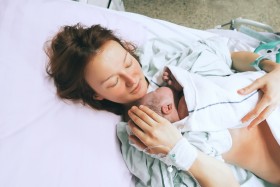Common Types of Umbilical Cord Problems

The umbilical cord is responsible for making sure an unborn child receives the oxygen and nutrients it needs to grow and develop. But if there are complications that impact the umbilical cord, the child can potentially lose the supply of oxygen they desperately need. Here are a few common types of umbilical cord problems that can potentially endanger a child if a doctor fails to take appropriate steps.
Umbilical Cord Prolapse
In some cases, the umbilical cord enters the birth canal before the baby’s head. As labor progresses, the umbilical cord can get compressed by the child’s body and cut off their oxygen supply. This is called umbilical cord prolapse and it occurs in about 1 in 300 births, which means it happens in less than 1% of births. Umbilical cord prolapse often doesn’t cause serious problems, but if it isn’t detected or reacted to quickly enough, it can potentially result in serious injury or death because of the lack of oxygen.
Causes & Risk Factors for Umbilical Cord Prolapse
There is no one main cause of umbilical cord prolapse, but there are several factors that can increase the risk. Some of the most common risk factors for umbilical cord prolapse include:
-
Premature birth
-
Low birthweight
-
Long umbilical cord
-
Carrying multiple babies
-
High levels of amniotic fluid
-
The baby is in a breech position
-
Membranes were ruptured to induce labor
Umbilical Cord Knots
Feeling your baby moving around during pregnancy can be very reassuring and exciting. But sometimes, the baby’s movements can cause the umbilical cord to get tangled and form knots. In many cases, the knots are loose enough to not constrict oxygen, but they can potentially become tighter during labor and delivery and result in the child receiving a lack of oxygen.
Signs of Umbilical Cord Knots
Umbilical cord knots can be visibly detected through an ultrasound. Aside from visible detection, a decreased fetal activity or heart rate can also be a symptom of an umbilical cord knot.
Risk Factors for Umbilical Cord Knots
Umbilical cord knots occur in about 1% of pregnancies and since they’re caused by the baby’s movements, they’re not possible to prevent. However, the following factors can increase the risk:
-
The baby is smaller than average in size
-
Long umbilical cord
-
High levels of amniotic fluid
-
Twins sharing an amniotic sac
Nuchal Cord
Nuchal cord is another umbilical cord problem most commonly caused by fetal movements. When nuchal cord occurs, it means the umbilical cord has become wrapped around the child’s neck. Usually, the cord only wraps around the neck once, but it can wrap around multiple times or form a knot. Nuchal cord is fairly common, occurring in upwards of 30% of births. The cord becoming wrapped around a baby’s neck won’t strangle it in a conventional sense, and it often doesn’t reach the point of becoming dangerous, but it it’s wrapped too tightly or forms a knot, it can cut off the baby’s oxygen supply, depriving it of oxygen in another way. Doctors are generally able to detect nuchal cord before labor begins and are often able to maneuver the cord off the neck.
Types of Nuchal Cord
Nuchal cords are classified in different ways depending on how the cord is wrapped. Sometimes, they are classified depending on how many times the cord is wrapped around the child’s neck, but they may also be classified based on how tightly it is wrapped around the neck. If a cord is wrapped around so tightly that it could not move over the baby’s head during delivery, it could be labeled a “tight” nuchal cord.
A nuchal cord can either be classified as Type A or Type B. Type A nuchal cords are also referred to as “unlocked,” meaning that it’s very likely the cord will become untangled by the baby’s natural movements. Type B nuchal cords are called “locked” because they have formed a true knot that will not clear up on its own.
Detecting Nuchal Cord
Nuchal cord often does not result in any physical symptoms, but can be detected through an ultrasound. However, nuchal cord isn’t always easy to detect even with an ultrasound and even if it can be detected, doctors may not be able to tell how severe a case of nuchal cord is by looking at an ultrasound.
Risk Factors for Nuchal Cord
As is the case for umbilical cord knots, since nuchal cord is often caused by the baby moving around, there isn’t much that can be done to prevent it. However, the following factors can increase the risk:
-
Pregnancies involving more than one baby
-
High levels of amniotic fluid
-
A long umbilical cord
Help With Michigan Birth Trauma Cases
If any of these umbilical cord problems are detected, it’s essential that doctors take steps to make sure the child’s oxygen supply isn’t being cut off for an extended amount of time. When these sorts of conditions aren’t treated appropriately and a loss of oxygen continues, the child may experience injuries like hearing loss, vision loss, brain injuries, or HIE. They may also experience developmental delays later in life. If there were complications with the umbilical cord during delivery and your child was injured as a result, contact a birth trauma lawyer right away. Injuries caused by a lack of oxygen can have long-term consequences, so it’s important to make sure they will have the care they need. Even if your child is a few years old, you may still be able to take legal action.
At Goodwin & Scieszka, we’re experienced in helping parents whose children have sustained injuries around the time of birth. Contact us today for help.






